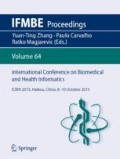Abstract
The mortality rate due to Cardiovascular Diseases is constantly gaining ground worldwide. Therefore, the early detection of coronary hemodynamic abnormalities is a non-trivial matter in today’s clinical practice. The assessment of coronary lesions is made using either invasive imaging techniques or by measuring the Fractional Flow Reserve value which also requires the use of a dedicated pressure wire. In this work, we present our newly developed novel 3-Dimensional Quantitative Coronary Analysis reconstruction method and its’ validation by comparing it to an already validated commercial 3D-QCA software. We used the volumes of the 7 3D reconstructed arterial segments as well as the virtual Functional Assessment Index values as validation metrics to compare the two methods. The obtained results show a very high correlation between the two methods presenting very high r2 values (0.98 and 0.99) and a very strong agreement between them.
Access this chapter
Tax calculation will be finalised at checkout
Purchases are for personal use only
References
K. Govindarajua, I.A. Badruddina, G. N. Viswanathanb, et al., “Evaluation of functional severity of coronary artery disease and fluid dynamics’ influence on hemodynamic parameters: A review,” Physica Medica, in press, 2012, https://doi.org/10.1016/j.ejmp.2012.03.008.
A.G. van der Giessen, M. Schaap, F.J. Gijsen, et al., “3D fusion of intravascular ultrasound and coronary computed tomography for in-vivo wall shear stress analysis: a feasibility study,” International Journal of Cardiovascular Imaging, vol. 26(7), pp. 781–796, 2010.
C.V. Bourantas, I.C. Kourtis, M.E. Plissiti, et al., “A method for 3D reconstruction of coronary arteries using biplane angiography and intravascular ultrasound images,” Computerized Medical Imaging and Graphics, vol. 29(8), pp. 597–606, 2005.
C.V. Bourantas, F.G. Kalatzis, M.I. Papafaklis, et al., “ANGIOCARE: an automated system for fast three dimensional coronary reconstruction using angiographic and intracoronary ultrasound data,” Catheterization and Cardiovascular Interventions, vol. 72(2), pp. 166-75, 2008.
L.M. Athanasiou, C.V. Bourantas, P.K. Siogkas, et al., “3D reconstruction of coronary arteries using Frequency Domain Optical Coherence Tomography images and biplane angiography,” Conf Proc IEEE Eng Med Biol Soc, vol. 2012, pp. 2647–50, 2012.
J.C. Schuurbiers, N.G. Lopez, J. Ligthart, F.J. Gijsen, J. Dijkstra, P.W. Serruys, A.F. Van der Steen, J.J. Wentzel, “In vivo validation of CAAS QCA-3D coronary reconstruction using fusion of angiography and intravascular ultrasound (ANGUS),” Catheter Cardiovasc Interv., vol. 73(5), pp. 620–626, 2009.
M. Malve, A. Garcia, J. Ohayon, et al., “Unsteady blood flow and mass transfer of a human left coronary artery bifurcation: FSI vs. CFD,” International Communications in Heat and Mass Transfer, vol. 39(6), pp. 745–751, 2012.
D. Bluestein, Y. Alemu, I. Avrahami, et al., “Influence of microcalcifications on vulnerable plaque mechanics using FSI modeling,” Journal of Biomechanics, vol. 41, pp. 1111–1118, 2008.
A. Borghi, N.B. Wood, R.H. Mohiaddin, et al., “Fluid-solid interaction simulation of flow and stress pattern in thoracoabdominal aneurysms: A patient-specific study,” Journal of Fluids and Structures, vol. 24(2), pp. 270–280, 2008.
S.A. Kock, J.V. Nygaard, N. Eldrup, et al., “Mechanical stresses in carotid plaques using MRI-based fluid-structure interaction models,” Journal of Biomechanics, vol. 41(8), pp. 1651–1658, 2008.
J.R. Leach, V.L. Rayz, M.R.K. Mofrad, et al. “An efficient two-stage approach for image-based FSI analysis of atherosclerotic arteries.” Biomechanics and Modeling in Mechanobiology, vol. 9(2), pp. 213–223, 2010.
B. Vahidi, and N. Fatouraee, “Large deforming buoyant embolus passing through a stenotic common carotid artery: A computational simulation,” Journal of Biomechanics, vol. 45(7), pp. 1312–1322, 2012.
R. Torii, M. Oshima, T. Kobayashi, et al., “Fluid-structure interaction modeling of a patient-specific cerebral aneurysm: influence of structural modeling,” Computational Mechanics, vol. 43(1), pp. 151–159, 2008.
S.H. Lee, H.G. Choi, and J.Y. Yoo, “Finite element simulation of blood flow in a flexible carotid artery bifurcation,” Journal of Mechanical Science and Technology, vol. 26(5), pp. 1355–1361, 2012.
M.X. Li, J.J. Beech-Brandt, L.R. John, et al., “Numerical analysis of pulsatile blood flow and vessel wall mechanics in different degrees of stenoses,” Journal of Biomechanics, vol. 40(16), pp. 3715–3724, 2007.
X.H. Wang, and X.Y. Li, “Fluid-structure interaction based study on the physiological factors affecting the behaviors of stented and non-stented thoracic aortic aneurysms,” Journal of Biomechanics, vol. 44(12), pp. 2177–2184, 2011.
J. Lantz, J. Renner, and Karlsson M., “Wall Shear Stress in a Subject Specific Human Aorta - Influence of Fluid-Structure Interaction,” International Journal of Applied Mechanics, vol. 3(4), pp. 759–778, 2011.
Vavourakis, Y. Papaharilaou, and J.A. Ekaterinaris, “Coupled fluid-structure interaction hemodynamics in a zero-pressure state corrected arterial geometry,” Journal of Biomechanics, vol. 44(13), pp. 2453–2460, 2011.
S.J. Park, J.M. Ahn, N.H. Pijls, et al., “Validation of functional state of coronary tandem lesions using computational flow dynamics.” Am J Cardiol. 110(11): 1578–84, 2012.
M.I. Papafaklis, T. Muramatsu, P.W. Serruys, et al., “Fast virtual functional assessment of intermediate coronary lesions using routine angiographic data and blood flow simulation in humans: comparison with pressure wire - fractional flow reserve,” Eurointervention, vol. 10(5), pp. 574–583. 2014.
D.F. Young, “Fluid Mechanics of Arterial Stenoses,” J Biomech Eng. Vol. 101, pp. 157–75, 1979.
Acknowledgements
This research project has been co-financed by the European Union (European Regional Development Fund-ERDF) and Greek national funds through the Operational Program “THESSALY-MAINLAND GREECE AND EPIRUS-2007–2013” of the National Strategic Reference Framework (NSRF 2007–2013) (M.I.S. Code-348133).
Author information
Authors and Affiliations
Corresponding author
Editor information
Editors and Affiliations
Ethics declarations
The authors declare that they have no conflict of interest.
Rights and permissions
Copyright information
© 2019 Springer Nature Singapore Pte Ltd.
About this paper
Cite this paper
Siogkas, P.K. et al. (2019). Quantitative Coronary Analysis Using 3D Coronary Reconstruction Based on Two Biplane Angiographic Images: A Validation Study. In: Zhang, YT., Carvalho, P., Magjarevic, R. (eds) International Conference on Biomedical and Health Informatics. ICBHI 2015. IFMBE Proceedings, vol 64. Springer, Singapore. https://doi.org/10.1007/978-981-10-4505-9_4
Download citation
DOI: https://doi.org/10.1007/978-981-10-4505-9_4
Published:
Publisher Name: Springer, Singapore
Print ISBN: 978-981-10-4504-2
Online ISBN: 978-981-10-4505-9
eBook Packages: EngineeringEngineering (R0)

